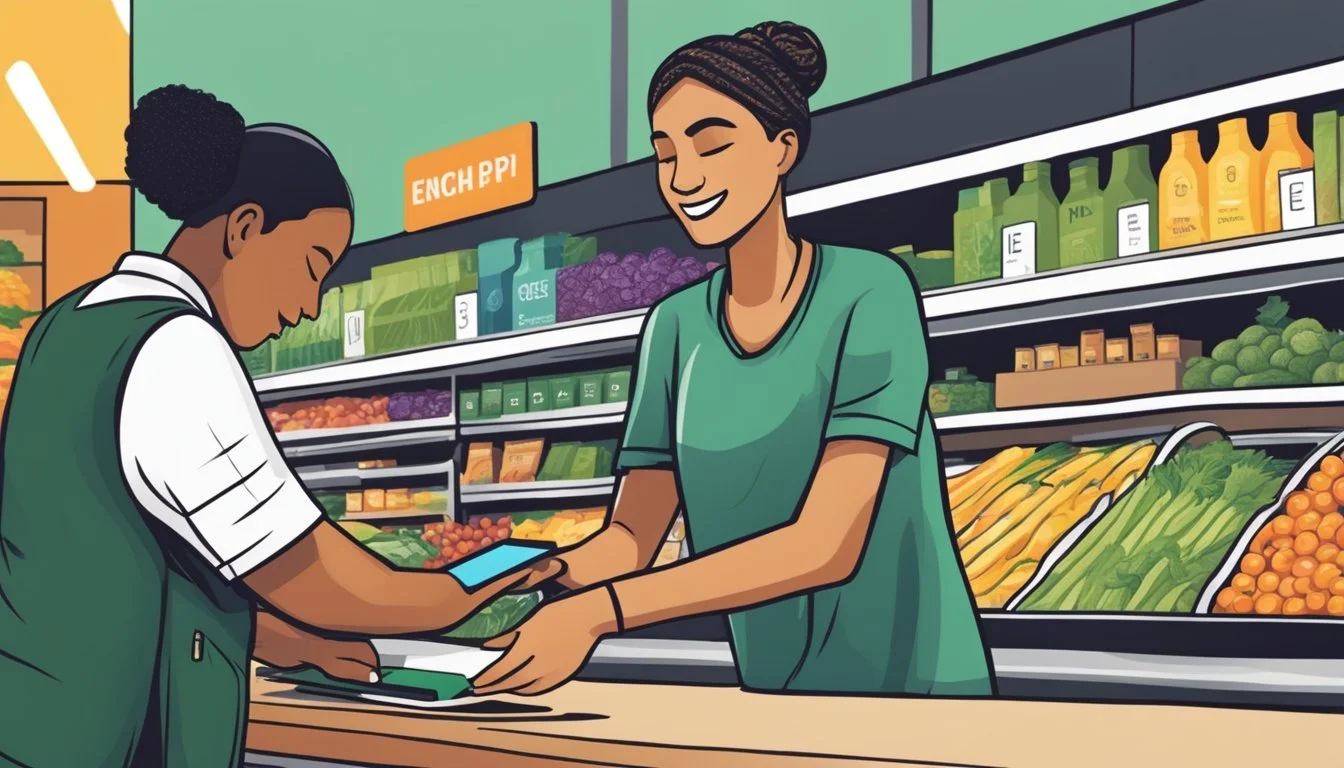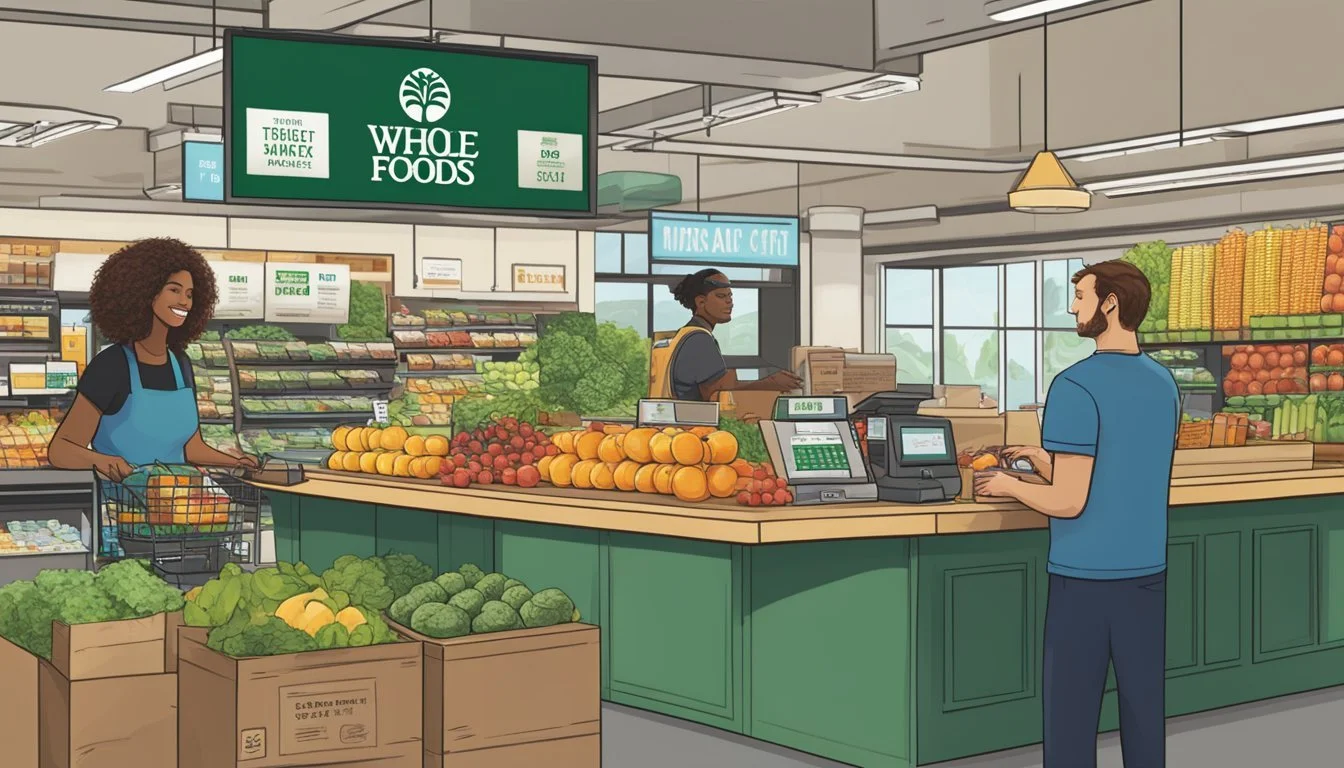Does Whole Foods Market Take EBT or SNAP?
Payment Options Explained
Whole Foods Market, known for its organic and healthy food options, has become a go-to destination for many shoppers looking to maintain a nutritious lifestyle. A common question is whether they accept EBT or SNAP benefits. The answer is yes, you can use your EBT or SNAP benefits at all Whole Foods Market locations for eligible in-store purchases.
While Whole Foods accepts EBT for in-person shopping, it's important to know that these benefits cannot be used to cover delivery or service fees. This means that while you can purchase groceries using your EBT card, additional charges for delivery services will need to be paid separately in accordance with USDA regulations.
Many people also inquire about the availability of WIC benefits at Whole Foods. It's worth noting that not all Whole Foods locations accept WIC, so it’s advisable to call your local store to confirm whether they participate in the program. This ensures that you can make the most of your benefits and enjoy the high-quality, organic foods that Whole Foods Market offers.
Understanding EBT and SNAP
The Supplemental Nutrition Assistance Program (SNAP) provides financial assistance to low-income individuals and families for purchasing food. The Electronic Benefits Transfer (EBT) card is used to access these benefits at authorized retail stores.
Basics of SNAP Benefits
The Supplemental Nutrition Assistance Program (SNAP) aims to reduce food insecurity by providing eligible households with funds to buy groceries.
Participants receive a monthly allotment based on their household size, income, and expenses. Acceptable items include fresh produce, meats, dairy products, and bread. Prepared foods, alcoholic beverages, and non-food items are not eligible for purchase with SNAP benefits.
Electronic Benefits Transfer Explained
The Electronic Benefits Transfer (EBT) system allows SNAP beneficiaries to utilize their funds conveniently. An EBT card, functioning like a debit card, stores their SNAP benefits and can be used at checkout to pay for eligible food items. Cardholders must enter their Personal Identification Number (PIN) to complete transactions, ensuring their benefits are secured just for them.
Periodic deposits are made to the cardholder's account, and they can check their balance through store receipts, online portals, or customer service. This system ensures that beneficiaries have access to their SNAP funds when needed.
Whole Foods Market's Acceptance of Government Assistance Programs
Whole Foods Market accepts various forms of government assistance, primarily focusing on SNAP/EBT and WIC. This enables many customers to purchase nutritious and organic products using their authorized benefits.
Policy on SNAP and EBT Card Usage at Whole Foods
All Whole Foods Market locations accept SNAP/EBT for in-store purchases. Customers can use their EBT cards to buy eligible food items directly at checkout.
Although the stores accept EBT for groceries, it’s important to note that SNAP benefits cannot be used for additional fees. For example, service fees associated with delivery are not covered by SNAP.
WIC Eligibility and Restrictions
Most, but not all, Whole Foods locations accept WIC (Women, Infants, and Children) benefits. It's recommended to call your local Whole Foods store to confirm if they accept these benefits.
WIC is designed to help pregnant women, infants, and young children by providing access to specific types of food. There may be restrictions on certain products, so it’s best to check with store personnel for a detailed list.
To summarize, Whole Foods showcases its commitment to supporting various government assistance programs, allowing more people the opportunity to access healthy and organic foods.
Shopping With EBT at Whole Foods Market
Whole Foods Market accepts EBT for eligible food items in all of its stores across the United States. It's important to know how to use your EBT card in-store and be aware of what you can and cannot buy with it.
How to Use Your EBT Card
Using an EBT card at Whole Foods Market is straightforward. At checkout, customers should swipe their EBT card and enter their PIN. It’s crucial to separate eligible food items from non-eligible products, as these must be paid for using another form of payment.
Most Whole Foods locations also provide a "Double Up Food Bucks" program, which can offer additional benefits to EBT users. Contact your local store to confirm these benefits and understand any state-specific rules for withdrawing funds.
Eligible Food Items
EBT cards can be used to purchase a wide range of food items at Whole Foods. EBT-eligible products typically include:
Fruits and Vegetables: Fresh, canned, and frozen
Meats: Poultry, beef, pork, and fish
Dairy Products: Milk, cheese, yogurt
Bread and Cereals: Fresh bread, bagels, cereals
Produce: Fresh organic and conventional produce
These items are essential parts of a nutritious diet and can be found throughout the store.
Ineligible Items and Restrictions
There are strict guidelines on what EBT cards cannot be used to purchase at Whole Foods Market. Some of the most common ineligible items include:
Prepared Foods: Deli and hot food items
Non-Food Items: Vitamins, supplements, paper products, and household supplies
Alcohol and Tobacco Products: Beer, wine, liquors, cigarettes
Additionally, EBT benefits cannot cover delivery fees or other service charges, including the $9.95 fee for delivery orders over $35. Customers must use another payment method for these costs.
Understanding these guidelines will help ensure a smooth shopping experience and maximize the benefits of the EBT program.
State-Specific Considerations for EBT
Different states may have unique rules and regulations regarding the use of EBT (Electronic Benefits Transfer). While Whole Foods Market accepts EBT in all its physical store locations across the United States, there are variations in how states implement these programs.
Some states allow EBT users to purchase groceries online. For example, in California, users can use their EBT card to order groceries online through platforms like Amazon, which services Whole Foods delivery.
Supplemental Nutrition Assistance Program (SNAP) benefits vary based on the state. In some states, additional items such as seeds and plants that produce food for the household to eat are eligible under SNAP. Be sure to check the specific state guidelines where you live.
Location-specific rules can affect accessibility. Not all Whole Foods locations within a state may accept Women, Infants, and Children (WIC) benefits. It's advisable to verify acceptance by contacting the store directly.
Checking ZIP codes is crucial. Certain delivery services may not be available in all ZIP codes within a state. This can impact the ability to use EBT for online orders. Always confirm if your ZIP code is serviced before placing an order.
Variations also exist in delivery and pickup services. While grocery pickup may be free for orders above a certain amount in some states, delivery fees typically apply and cannot be paid using EBT.
For specific questions regarding EBT usage in a particular state, contacting your local SNAP office or visiting the state's SNAP website can provide accurate information.
Navigating Whole Foods Market with EBT
Whole Foods Market accepts EBT cards for eligible food items in-store, while certain restrictions apply for delivery. This section explores how to find EBT-eligible products and the process for checking out with an EBT card at Whole Foods.
Finding EBT Eligible Products
At Whole Foods, EBT cards can be used to purchase a variety of items. SNAP-eligible products include essentials such as bread, cereals, poultry, dairy products like milk and cheese, canned and frozen foods, vegetables, red meat, pork, and various cooking oils.
Non-eligible items include hot foods, prepared foods, and non-grocery items like toiletries or household goods. For precise information, shoppers can verify eligibility by checking the item's label or asking a store associate. Utilizing lists provided by SNAP and Whole Foods’ guidelines can make the process more manageable.
Checking Out With EBT at Whole Foods
When ready to pay, customers should go to the cashier with their grocery store items. At checkout, it's important to inform the cashier that part of the transaction will be paid using an EBT card.
The cashier will swipe the EBT card, and the customer will need to enter their PIN for authentication. Ensure that funds are available on the card and that only SNAP-eligible items are being purchased with EBT. If using the card for multiple payment methods, coordination with the cashier will streamline the process.
Whole Foods also offers EBT payment for delivery and pickup orders through Amazon, though delivery fees and service charges cannot be paid with EBT and must be covered by another payment method.
Benefits of Buying Organic and Healthy Options with EBT
Using EBT to buy organic food offers several health and environmental benefits. Organic food is often free from synthetic pesticides and fertilizers, which can lead to fewer health risks and a cleaner environment.
Nutrient Content
Organic fruits and vegetables can be more nutritious. They are known to contain higher levels of certain vitamins and minerals, which are essential for good health.
Healthier Meat Options
Purchasing organic meat with EBT ensures that the meat is free from antibiotics and hormones, making it a healthier choice for families.
Access to Fresh Vegetables and Fruits
EBT users can buy fresh organic vegetables and fruits. These options are often fresher and better for overall health.
Support for Sustainable Farming
Buying organic supports sustainable farming practices, which are better for the environment. This includes better soil health and biodiversity.
Improved Dietary Choices
Access to healthy food such as organic products can lead to better dietary choices, improving overall well-being.
Budget-Friendly Organic Options
Whole Foods Market provides a variety of budget-friendly organic options, making it easier for EBT users to make healthier choices without overspending.
Online Shopping and EBT Requirements
Whole Foods Market accepts EBT for in-store purchases, but there are specific rules regarding online shopping and service fees that customers must be aware of. Amazon Prime members and others using online services should note the distinctions for pickup and delivery.
Whole Foods Online Purchases
Whole Foods Market supports online purchasing, though paying with EBT online has limitations. While EBT is accepted for in-store purchases, it cannot be used for online grocery deliveries or to cover service fees. For instance, Whole Foods delivery orders include a $9.95 service fee, particularly for orders over $35, which cannot be paid using EBT benefits.
Understanding that USDA guidelines prohibit using SNAP EBT benefits for service fees is crucial for planning online purchases through Whole Foods. Thus, shoppers must make alternative arrangements to cover these costs if they choose online shopping options.
Curbside Pickup and Delivery
For grocery pickup, Whole Foods offers a complimentary service for eligible orders, but there are details to consider for using EBT. Pickup orders made through Whole Foods Market do not incur additional charges, making it a viable option for those using EBT.
Amazon Prime members benefit significantly from this service, avoiding unnecessary fees. However, be aware that any additional charges, such as rush options, are not covered by EBT. Planning and timely order placement can help minimize extra costs, ensuring that SNAP benefits are used effectively for grocery needs.
Additional Payment Methods at Whole Foods Market
Whole Foods Market offers various payment methods to cater to different customer preferences. Here's a breakdown of the options available:
Cash: Customers can pay for their purchases using cash at any Whole Foods checkout line. This traditional method remains widely accepted.
Debit Cards: Debit cards are a popular payment method at Whole Foods. They are accepted across all store locations, providing a quick and convenient way for customers to pay directly from their bank accounts.
Credit Cards: Major credit cards, including Visa, MasterCard, American Express, and Discover, are also accepted. This allows flexibility for customers who prefer to use credit for their purchases.
Mobile Payments: Whole Foods supports mobile payment options like Apple Pay, Google Pay, and Samsung Pay. Customers can easily make transactions using their smartphones for a contactless experience.
Amazon Pay: As an Amazon-owned company, Whole Foods also accepts Amazon Pay. This allows customers to use their Amazon account balance to pay for groceries and other items.
Gift Cards: Whole Foods gift cards can be used as a payment method. These cards can be purchased online or in stores and are a great option for gifting.
SNAP/EBT: Whole Foods allows in-person purchases using Supplemental Nutrition Assistance Program (SNAP) EBT cards. Customers can buy eligible food items, though delivery and service fees cannot be covered by EBT.
These various payment methods ensure convenience and flexibility, enhancing the shopping experience at Whole Foods Market.
Support and Assistance for EBT Shoppers
Whole Foods Market provides multiple options to assist EBT shoppers, ensuring a smooth and accessible shopping experience both in stores and online. These resources include a dedicated EBT customer service line and comprehensive in-store assistance and guides.
EBT Customer Service Line
Whole Foods offers an EBT Customer Service Line to help shoppers with any queries related to using EBT cards in their stores. This service line can provide information on EBT card balance, transaction issues, and store policies related to EBT usage.
This resource is particularly useful for resolving issues quickly without needing to visit the store. To get assistance, customers can find the contact information on the Whole Foods Market website or at their local store.
The customer service representatives are trained to handle EBT-specific inquiries, ensuring targeted and effective support for EBT cardholders.
Store Assistance and Guides
In-store assistance is readily available for EBT shoppers at Whole Foods. Store associates are trained to help with EBT transactions and can guide shoppers through the process of using their EBT cards. Shoppers should approach any cashier with their EBT card and ID for assistance.
Whole Foods also provides guides and informational brochures on how to use EBT at their stores. These materials are designed to help shoppers understand which products are eligible for purchase using EBT benefits and how to complete transactions seamlessly.
Additionally, visual aids such as signs and labels within the store can help identify EBT-eligible items, making the shopping experience more straightforward.
Promotions and Savings for SNAP Beneficiaries
Whole Foods Market offers various promotions and savings options for SNAP beneficiaries to make nutritious foods more affordable. Summer Savings promotions often run during the warmer months, providing discounts on fresh produce, beverages, and barbecue essentials.
Save Up to 25% on select items during Limited-Time-Only Savings events, which are periodically held throughout the year. These events feature discounts on a rotating selection of grocery items, including fresh fruits, vegetables, dairy products, and pantry staples.
SNAP beneficiaries can use their EBT cards to purchase eligible food items during these promotions, making it easier to maximize their budget. Whole Foods Market sometimes collaborates with local organizations to provide additional savings and support for the community.
Keep an eye on Whole Foods' weekly ads and in-store signage to stay updated on the latest promotions and savings opportunities. By combining these discounts with SNAP Benefits, shoppers can stretch their dollars further and enjoy a wider variety of healthy and delicious foods.
Whether shopping in-store or online, it's beneficial for SNAP recipients to explore these promotions and take advantage of the savings available to them.
Local Collaboration and Sustainable Food Choices
Whole Foods Market prioritizes local collaboration and sustainable food choices, enhancing their commitment to nourishing people and maintaining quality food standards.
Featuring Local Artisans and Brands
Whole Foods Market showcases local artisans and brands, providing a platform for them to reach a broader audience.
By featuring locally sourced products, they support smaller businesses and ensure that shoppers have access to fresh, unique items.
This initiative not only boosts the local economy but also offers customers a diverse selection of high-quality, sustainably sourced foods.
Examples of collaborations include partnerships with local farms, bakeries, and beverage makers, ensuring that products are fresh and sustainably produced.
Key benefits:
Supports local economy
Reduces carbon footprint through shorter supply chains
Supporting Local Communities
Whole Foods Market invests in local communities by participating in various charitable initiatives and programs.
Their community giving programs contribute to addressing immediate and emerging needs, collaborating with nonprofit organizations.
Whole Foods supports food banks, educational programs, and other local initiatives focused on better nutrition and sustainability.
These efforts are part of their broader mission to nourish communities and ensure that sustainability principles are embedded in everyday operations.
Key activities:
Donating to food banks
Educational programs for better nutrition
Support for local non-profits
These initiatives are central to their commitment to making a positive local impact and promoting sustainable food practices within the communities they serve.









